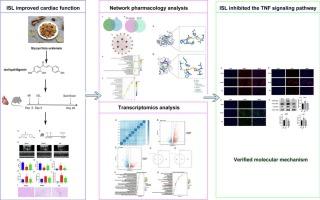整合网络药理学和转录组学,探索isoliquiritigenin治疗心肌梗死诱发的心力衰竭的机制。
IF 3.3
3区 医学
Q2 PHARMACOLOGY & PHARMACY
引用次数: 0
摘要
背景:炎症反应和心肌重塑在心肌梗塞(MI)后心力衰竭(HF)的发展过程中起着至关重要的作用。Isoliquiritigenin (ISL) 具有抗炎特性,已被用于研究动脉粥样硬化等心血管疾病。然而,ISL 对 MI 引起的高血压的影响和机制仍不清楚。本研究旨在以网络药理学、转录组学和实验验证为基础,探讨ISL治疗HF的作用和机制:我们建立了 MI 诱导的 HF 小鼠模型,通过灌胃给药 ISL 28 天。收集了小鼠的超声心动图数据,并进行了病理染色。然后进行了网络药理学和分子对接。我们还对小鼠心肌组织进行了转录组分析。最终,我们整合了转录组数据和网络药理学,揭示了其潜在机制,并通过体内实验验证了结果。我们的实验表明,ISL 能改善心肌缺血引起的高房颤动小鼠的心功能、保护心肌结构、抑制胶原纤维堆积、减少炎症因子分泌并减轻心肌细胞凋亡。结合转录组学和网络药理学分析发现,ISL 与高房颤相关的核心靶点明显富集在肿瘤坏死因子(TNF)信号通路中。分子对接验证表明,ISL与这些核心靶点有很强的结合力。此外,体内实验验证了 ISL 可通过抑制 TNF 信号通路来预防心肌梗死后的高房血症:我们阐明了 ISL 治疗心肌梗死后高房颤的抗炎和抗心肌重塑机制,其中涉及 TNF 信号通路。本文章由计算机程序翻译,如有差异,请以英文原文为准。

Integration of network pharmacology and transcriptomics to explore the mechanism of isoliquiritigenin in treating heart failure induced by myocardial infarction
Background
The inflammatory response and myocardial remodeling play critical roles in the progression of heart failure (HF) following myocardial infarction (MI). Isoliquiritigenin (ISL) possesses anti-inflammatory properties and has been investigated in cardiovascular diseases such as atherosclerosis. However, the effects and mechanism of ISL on MI-induced HF remain unclear. This research aimed to explore the effects and mechanism of ISL in the treatment of HF on the basis of network pharmacology, transcriptomics, and experimental verification.
Methods and results
We established an MI-induced HF mouse model in which ISL was administered via gavage for 28 days. Ultrasonic cardiogram data were collected from the mice, and pathological staining was conducted. Then, network pharmacology and molecular docking were performed. Transcriptomic analysis was also conducted on mouse myocardial tissue. Ultimately, we integrated transcriptomic data and network pharmacology to reveal the underlying mechanism, with the results verified through in vivo experiments. Our experiments indicated that ISL improved cardiac function, preserved myocardial structure, inhibited collagen fiber accumulation, reduced inflammatory factor secretion, and mitigated myocardial cell apoptosis in mice with MI-induced HF. A combination of transcriptomics and network pharmacology analysis revealed that core targets of ISL related to HF were significantly enriched in the Tumor Necrosis Factor (TNF) signaling pathway. Molecular docking validation demonstrated that ISL shows strong binding to these core targets. Additionally, in vivo experiments verified that ISL protects against HF post-MI by inhibiting the TNF signaling pathway.
Conclusion
We clarified the anti-inflammatory and antimyocardial remodeling mechanisms of ISL in the treatment of HF post-MI, which involves the TNF signaling pathway.
求助全文
通过发布文献求助,成功后即可免费获取论文全文。
去求助
来源期刊
CiteScore
6.80
自引率
2.60%
发文量
309
审稿时长
32 days
期刊介绍:
Toxicology and Applied Pharmacology publishes original scientific research of relevance to animals or humans pertaining to the action of chemicals, drugs, or chemically-defined natural products.
Regular articles address mechanistic approaches to physiological, pharmacologic, biochemical, cellular, or molecular understanding of toxicologic/pathologic lesions and to methods used to describe these responses. Safety Science articles address outstanding state-of-the-art preclinical and human translational characterization of drug and chemical safety employing cutting-edge science. Highly significant Regulatory Safety Science articles will also be considered in this category. Papers concerned with alternatives to the use of experimental animals are encouraged.
Short articles report on high impact studies of broad interest to readers of TAAP that would benefit from rapid publication. These articles should contain no more than a combined total of four figures and tables. Authors should include in their cover letter the justification for consideration of their manuscript as a short article.

 求助内容:
求助内容: 应助结果提醒方式:
应助结果提醒方式:


